

If you have any further questions or would like to chat, please contact us via any method below.
- 01603 291919
- info@thenorwichfaceandbodyclinic.co.uk
- Whatsapp Message Us




Pigmentation is seen in many forms and affects more than 65 per cent of individuals in their lifetime.
Freckles, age spots, sunspots, hyperpigmentation, melasma, liver spots or plain pigmentation: whichever type it may be, irregular skin discolouration is a common and distressing problem.
Pigmentation can increase due to the primary factors below:
Pigmentation refers to changes in your skin’s melanin (pigment), and the different types will respond best to specific treatments/products designed for that type.
As mentioned above, there are many causes of pigmentation, and the appearance will vary from person to person. No matter the reason, pigmentation is excessive melanin production in the skin. Melanin is what gives skin its colour, and where pigmentation is present. It is an extreme concentration of it in one or many areas causing these dark/discoloured marks.
Common types of pigmentation we treat:
Post-inflammatory hyperpigmentation (PIH).
Post-inflammatory erythema (PIE)
Both happen as the result of inflammation, and often occur post acne or from trauma or irritation to the skin.
Post-inflammatory hyperpigmentation (PIH) is light or dark brown marks caused by the overproduction of melanin.
If you don’t know what melanin is: it’s simply the pigment that gives colour to human hair, skin, and eyes. Cells that produce melanin are called melanocytes. And the process of melanin production is called melanogenesis.
Let’s break it down…
Darker skin tones are more likely to get PIH because they have overactive melanocytes.
PIH is triggered by an inflammatory response that initiates melanin production. Possible causes include getting a spot, ageing, pregnancy (melasma), hormones, and sun exposure.
Melanin protects your skin from the sun by absorbing 50-75% of UV radiation. More melanin means less susceptibility to sunburn. People with a darker skin tone do not burn as quickly because they have more melanin to protect themselves.
Why is this important? Because the sun causes your skin to produce more melanin to protect itself. Melanin is the culprit behind hyperpigmentation issues. The less work we give to our melanocytes, the better for treating PIH.
And this is why, if you have ever been to the clinic or follow us on social media, you will know why we go on and on about the importance of SPF! Wearing a broad-spectrum SPF daily is super important! SPF works by absorbing UV radiation, so melanin doesn’t have to. In other words, SPF is doing the hard work so your melanocytes can relax. As a result, less melanin is produced, resulting in less hyperpigmentation.
Treating PIH is twofold: inhibit tyrosinase (an enzyme that catalyses melanin production) and increase cell turnover rate so the spots fade faster. Also, use sunscreen! LOTS and LOTS of sunscreen!
As mentioned above, melanin production is the driving force behind post-inflammatory hyperpigmentation. The more we can limit melanin production then the less hyperpigmentation problems we will have.
The concept behind increasing cell turnover to help PIH is pretty straightforward. The faster your cells renew and shed off old skin then the less time we’ll wait for PIH to go away.
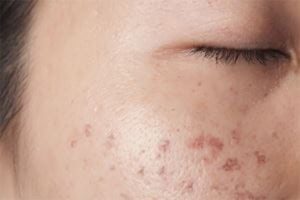
Many people will call P.I.H. pigmentation.
If you are looking to treat pigmentation in Norwich, including sunspot removal, please book a skin therapy consultation online via the link below.
The most suitable treatment we offer to treat P.I.H. is:
The Prescription Resurfacing Facial. You may require these facial treatments every 4-6 weeks to reduce inflammation and hydrate the skin. This facial is £199 per treatment.
We also advise a specific skincare range of products, the pHformula M.E.L.A OR C.R Kit, for a recommended minimum of 12 weeks. Our skin specialist prescribes the products.
The pHformula kits are a 2–3-month kit that costs £175.
Post Inflammatory Erythema (PIE) are the red, pink, or purple marks from inflammation (usually acne). This is a very common concern and something we see a lot of. If you are suffering from acne, please please get the correct advice to help your skin heal; some people will form PIE after acne whilst others will pick their skin and use the wrong products leading to pitted acne scars, which will take a lot of time and money to repair. If you have acne, get on the right track NOW.
You may notice these spots are red not brown. That is one of the main ways you can tell the difference between PIE & PIH This redness is a result of discrete erythematous macules or damage/dilation done to the capillaries (tiny blood vessels) close to the skin resulting in little red spots often mistaken as acne,
PIE is more common in lighter skin tones and is less likely to affect people with a slightly darker skin tone. Some people will have a mix of both PIH and PIE. PIE can sometimes turn into PIH if left untreated.
Treatments that treat PIH aim to inhibit melanin production, which unfortunately does nothing for PIE because it is not a melanin-induced problem.
What causes PIE:
PIE is inflammation caused by trauma. This may be inflamed acne, picking at spots, popping spots, dry or dehydrated skin, chemical burns, over-exfoliation, cuts, scrapes, scratches, sunburn, sun exposure and some other types of trauma.
How to test for Post Inflammatory Erythema (PIE).
Post-inflammatory erythema disappears temporarily when pressure is applied to the area. PIH does not. This is known as “skin blanching”.
To do this test on yourself, find a transparent container such as a cup or glass, and press the item down against the area you might suspect is PIE. If the mark becomes white and disappears, then that’s a good indication you have PIE and not PIH.
Hyperpigmentation (brown spots) is unaffected by this test. However, this method isn’t always the most accurate and should be used more as a guide.
The science behind treating Post Inflammatory Erythema (PIE):
There are only two main methods for treating PIE (as far as the research is concerned): vascular lasers and specific skincare products.
As mentioned above, PIE is the result of damaged or enlarged capillaries near the surface of the skin. That’s what can make vascular lasers such an effective treatment. They work by penetrating the skin deep enough to reach, break down, and disperse the damaged blood vessels, causing PIE.
Specific skincare products increase the hydration of the stratum corneum (outermost layer of skin), protect from bacterial invasion, and maintain skin barrier integrity.
They induce a moist wound healing environment to speed up the PIE-fading process.
It is said that post-inflammatory erythema (PIE) is worsened by a damaged moisture barrier or acid mantle, so focusing on the moisturising aspect of your routine and reducing irritation whenever possible is essential!
The key takeaway is to hydrate, hydrate, and hydrate some more!
Many people will call PIE acne scars when they are more of an acne stain!
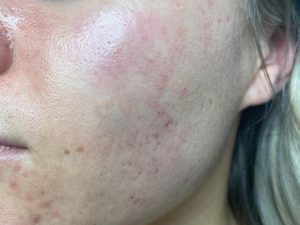

If you are looking to treat these acne marks on the skin in Norwich, please book a skin therapy consultation online via the link below.
The most suitable treatment we offer to treat PIE is:
The Prescription Resurfacing Facial. You may require these facial treatments every 4-6 weeks to reduce inflammation and hydrate the skin. This facial is £199 per treatment.
We also advise a specific skincare range of products, the pHformula C.R Kit for a recommended minimum of 12 weeks. Our skin specialist prescribes the products.
The pHformula C.R. is a 2–3-month kit that costs £175.
THE FACTS:
Age spots or liver spots are a common form of hyperpigmentation caused by sun damage and are referred to by some medical professionals as solar lentigines. They are usually found on the hands and face but can also be visible in other areas that are frequently exposed to the sun; these will most likely increase with age. Age spots can vary in colour from brown to grey to black. They can also be very small or quite large and sometimes appear in groups or clusters. They are common in people with fair skin who don’t have as much natural protection from the sun. These pigmentation marks are mostly caused by sun damage over time; they are not caused by ageing but can worsen as you age hence why they are sometimes known as age spots.
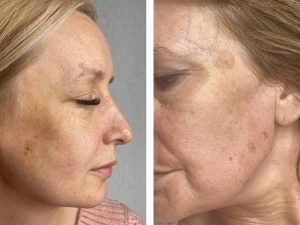

If you are looking for an “age spot removal in Norwich”, please book a consultation and patch test online via the link below.
Not sure which treatment you need? Send us a WhatsApp message or email with a variety of clear images of the treatment area, and we will recommend the most suitable treatment. Alternatively, book an in-clinic skin therapy consultation.
Melasma or chloasma is a type of pigmentation that is deeper in the skin’s dermis. It appears on the face as larger brown patches with a non-distinct border. Melasma is thought to be caused by increasing levels of both oestrogen and progesterone, which stimulate melanocytes.
Melasma appears as patches of pigment and is usually found on the cheeks, temples, upper lip, and forehead but can also be found on the body. Like all types of pigmentation, Melasma is hugely aggravated by exposure to the sun.
This type of pigmentation is also known as a ‘pregnancy mask’ because of its prominence in pregnant women and its appearance as ‘mask like’ patches on the face.
Melasma is generally the most difficult type of pigmentation to remove, and it is important to understand this pigment will lighten up to 90% but will require maintenance as they will return in time.
The most suitable treatment we offer for this type of pigmentation is the Obagi Nuderm medical skincare range.
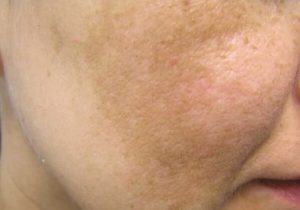

If you are looking for a “treatment for melasma near me”, please book a skin therapy consultation online via the link below; this will allow our skin specialists to confirm the type of pigmentation and establish the level at which the pigment sits within the skin.
There are two kit options for the Nu-derm:
Obagi Nu-Derm 1–2-month trial Kit from £299
Obagi Nu-Derm 3-4-month Full Kit from £499
Not sure which pigmentation you have? send us a WhatsApp message or email with a variety of clear images of the treatment area, and we will recommend the most suitable treatment and products. Alternatively, book an in-clinic skin therapy consultation.
Healthy Skin
Skin is the barrier that segregates the body from the outer environment.
The skin regenerates on a 28-day cycle. So, in 4 weeks the cells of your skin move from the bottom of the epidermis to the surface of your skin. The epidermis slows the loss of moisture from the dermis (the lower layer). This dermis is made up of collagen and elastin. It’s important to keep it hydrated as this keeps your skin more elastic, healthier, and youthful. A proper skincare routine is essential to achieving and maintaining a healthy skin barrier.
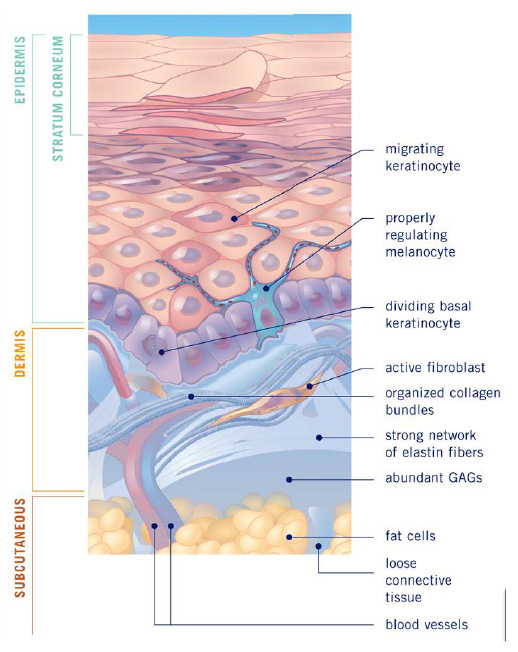

Over-the-counter skincare products have been designed to suit most of the population. Companies do this to not negatively affect the skin of the general population. For this reason, the concentration of their active ingredients is relatively low and will have minimal effects on skin concerns such as acne, pigmentation, rosacea, and scarring.
Our products are made with more potent ingredients and can only be purchased or prescribed by Lauren (an advanced skin specialist) or Dr Shah (One of our clinic doctors). They have been developed and researched to the point that they have sufficient active ingredients to make changes in your skin. A higher amount of the active ingredient = better quality and results!
In addition, to having a higher active ingredient content, our products are made using the latest technology and can be adapted to your skin issues.
Over-the-counter products are designed to sit on the surface of the skin, whereas our products have been designed to penetrate the epidermis and affect deeper layers of the skin=Better results!
Advice from our Skin Specialists
“Be mindful that it takes time and commitment to see those all-important changes to your skin. Think of your in-clinic appointments and home skincare regime in the same way as exercising – it takes consistency and maintenance to see positive and lasting results. We are confident that by having regular appointments with us and doing your bit at home, we can help you achieve your best skin!”
Lauren and Rebecca.
Not sure which treatment you need? Send us a WhatsApp message with a variety of clear images of the treatment area, and we will recommend the most suitable treatment.



 Tues–Sat
Tues–Sat
